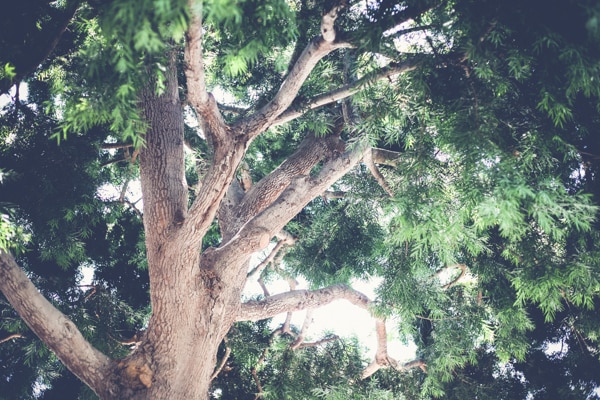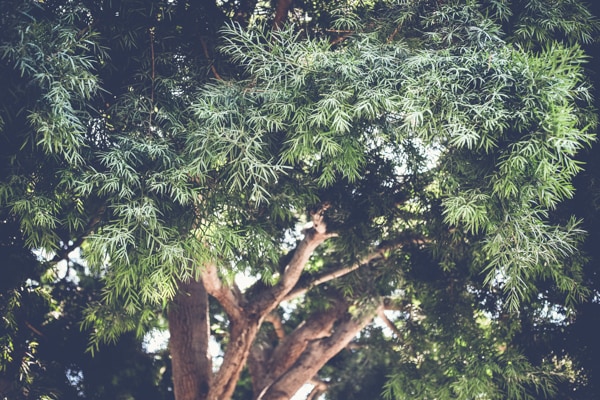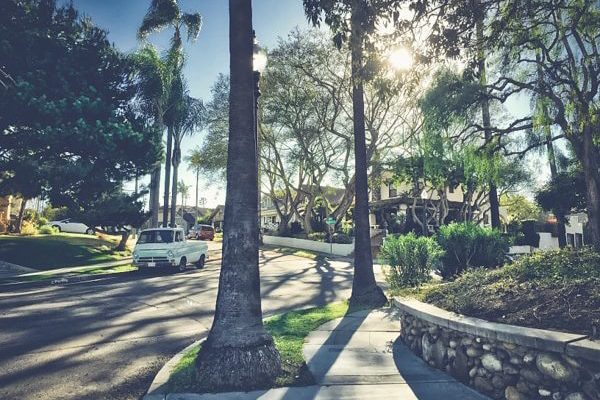
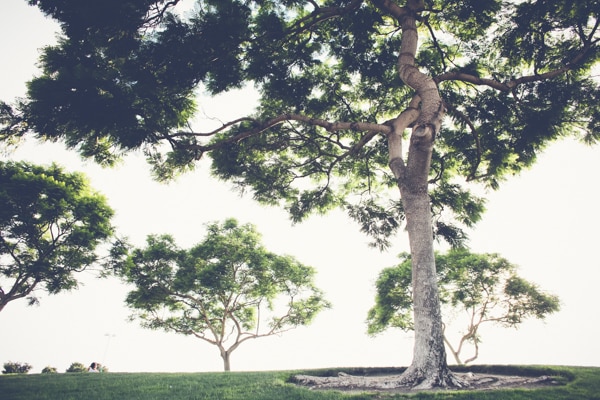
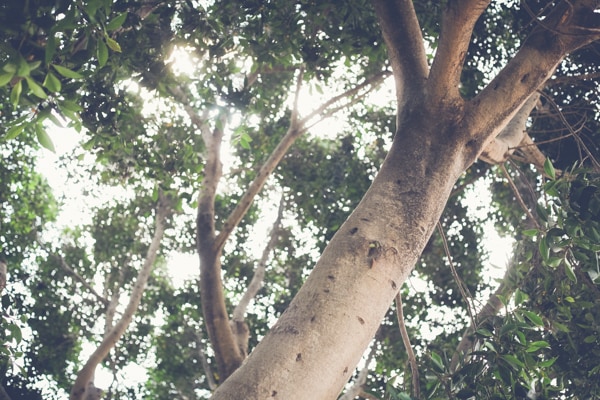
The beautiful city of San Diego is renown for its near-perfect year-round weather. Receiving an average of 266 sunny days and less than 12 inches of precipitation annually, along with its mild winters and summers, classifies this wonderful city as a Mediterranean climate. Much of San Diego’s terrain consist of scrubland, which is land covered predominantly by scrub vegetation. By nature, scrublands do not grow tall trees due to the low amounts of rainfall. The only exception are the scrublands of Australia, where many towering eucalyptus tree species (which are freaks of nature in itself) originate from.
With the region’s sunny and mild climate, almost any tree can grow in San Diego, as long as they are properly cared for. Just visit the San Diego Zoo, and you’ll observe how exotic plants and trees from all around the world thrive, like those indigenous to Madagascar or the Asian tropical rainforests.
Although you see trees with their attractive greenery all over San Diego, did you know that most of them are not native to this area? Many were introduced to Southern California in the late 1800’s and early 1900’s, during the time of the California Gold Rush or during the life of famed botanist and “Mother of Balboa Park”—Kate Sessions. Before this time, most of San Diego’s natural terrain consisted of mostly dirt and brush. Not the most appealing to the eye—unless you’re into that sort of brown, scrubby look.
So since the influx of trees into our region, what have become the most popular trees in San Diego, where did they come from, and what type of maintenance do they require?
In no particular order of popularity, here are our picks for the 10 Most Popular Trees in San Diego.
1
PALMS
When people think of San Diego and Southern California, what tree do you think they envision in the backdrop the most? Why, the palm tree, of course!
Here’s a bit of arboricultural knowledge for you—did you know that palms are actually not trees? Technically, they are more related to grass and bamboo than they are trees. They are monocots, which means that their seeds produce a single cotyledon, or embryonic leaf. All other trees are either dicots (i.e. oak trees and fruit trees) or conifers (i.e. pines). By definition, palms are nowhere close to being a tree. They do not have lateral branches, and they do not possess secondary growth—a term used in reference to the outward growth of a tree’s trunk and limbs—forming the age rings that we see in wood cuttings.
While palms are not true trees, even your average arborist will refer to them as palm trees—which is why they managed to creep their way into our list of the 10 Most Popular Trees in San Diego. It’s almost unfair to have to consolidate all palms into one item on our list, but if they were segregated, they would end up dominating half of the list. That is because San Diego is home to hundreds of thousands of these hardy, fast-growing “trees.” You see them on practically every street—and in most neighborhoods, you can can see them from almost any home. There are about 2,600 palm species throughout the world, but only a handful are common sights in San Diego—the tough, but messy MEXICAN FAN PALM, the feathery QUEEN PALM, the handsome KING PALM, the dainty, little PYGMY DATE PALM, and the majestic DATE PALMS.
For a more detailed description on these palms, feel free to read our 6 Most Common Palms in San Diego article.
Origins
As iconic as these trees are to Southern California, only one palm species can make a claim of being a true San Diego local, and it isn’t even one of the most popular palms in this region. It’s the California fan palm—similar in sight to the Mexican fan palm, but nowhere as abundant. In fact, this true local is a rare sight in San Diego.
Our most common palms originated from other countries: Mexico, South America, Africa, the Middle East, Asia, and Australia. Palms are believed to have been introduced to California by 18th century missionaries, who planted them for their Mediterranean appeal and biblical reference. But they didn’t take California by storm until the city of Los Angeles undertook an ENORMOUS beautification project in preparation for the 1932 Olympics. As a result, more than 40,000 palms were planted in a span of a couple of years—catapulting Los Angeles’ high-status, leisurely vibe. With San Diego being in such close proximity, it was just a short period of time before the palm craze filtered its way down to our city.
Maintenance
Due to their aesthetic appeal and hardiness, palms are popular both on city land and private property. Since the Mexican fan palm is tough-as-nails, it has become the most popular choice for city landscaping, which is why they have become iconic to Southern California. But with the hardiness, also comes the mess, as these palms are the most high-maintenance when it comes to appearance. If the fan palm is neglected, its dead fronds collect into an unsightly skirt that becomes an ideal sanctuary for rodents.
While the other common palms in San Diego may not be as resilient as the Mexican fan palm (but they still are hardy), they aren’t as needy when it comes to maintaining their looks. Two of them, the queen and king palm, are even self-pruning and will drop their dead fronds on their own if left untrimmed. The pygmy date palm is so little that even a gardener or homeowner can easily trim off the excess fronds.
A great trait about palms is that they don’t cause a mess of fallen leaves or blooms, and you don’t have to worry about weak branches falling—but all of the common palms do require annual maintenance to remove their seed pods. Depending on the palm, these seed pods can grow huge, and when they open, they rain down a widespread mess of thousands of seeds. It’s like your child taking a box of LEGOS and scattering them all over the house. A lovely nuisance of a mess!
Palms have become so popular, not only for their looks, but because in our dry climate, they just make sense. They are all moderate to highly drought tolerant. The most sensitive being the pygmy date palm and king palm; and the most tolerant being the Mexican fan palm and date palm. The lovely queen palm stands right in the middle.
While they may be generally easy to maintain, palms can be susceptible to diseases and pests, like Fusarium wilt and the South American palm weevil, that has been threatening and destroying highly-valued Canary Island date palms throughout San Diego.
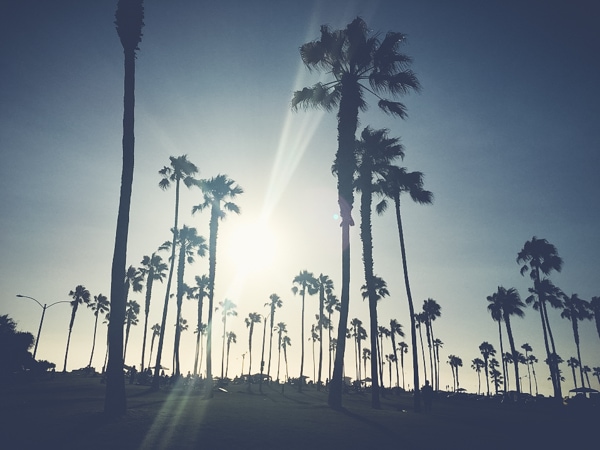
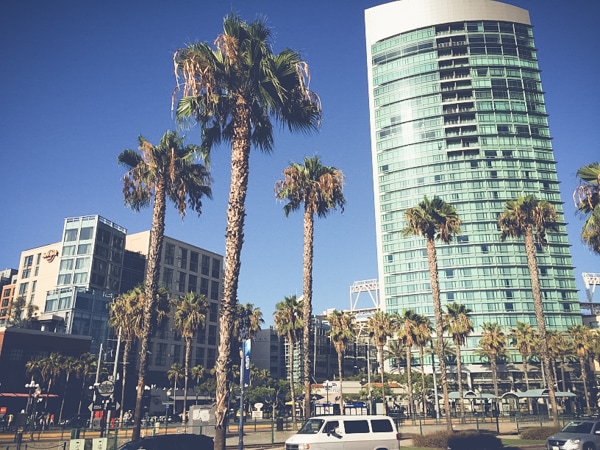
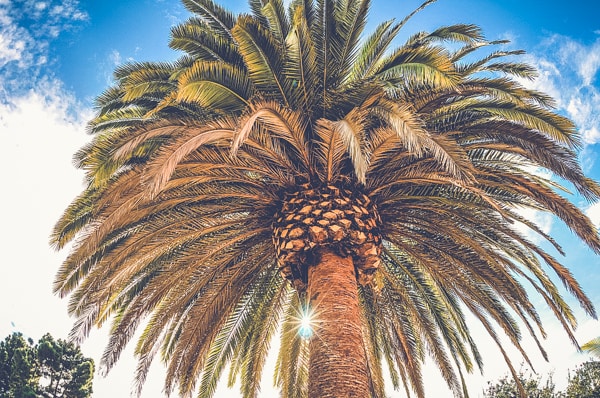
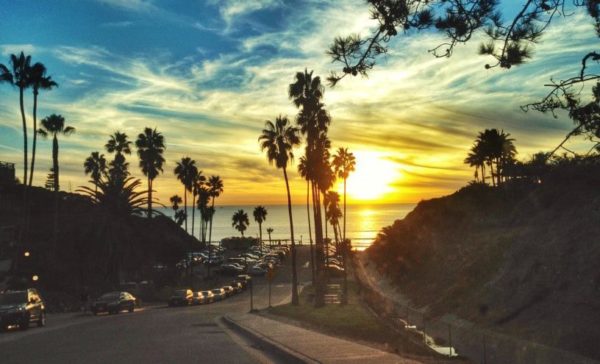
2
JACARANDA TREE
During the late spring and early summer months, San Diego landscape comes alive with the lavender flowers of the jacaranda tree. Then…one month later…the streets and grounds become littered with brownish-purple flowers, and residents and groundskeepers are forced to bring out the rakes, brooms, and blowers. But even though the pastel beauty of these trees is fleeting and eventually causes a cleanup project, it must be worth it, because the jacaranda tree is one of the favorites among local San Diegans for ornamental tree choices.
Origins
While San Diego is a dry climate, the jacaranda is actually a tropical and subtropical tree—claiming its roots in the Caribbean and Central and South America. The beauty of this tree fascinated explorers, who collected samples and brought them to their homelands. In the 18th and 19th centuries, the tree began its spread throughout the world to Portugal, Europe, South Africa, Australia, Asia, and North America. With their purple hues coloring the streets and land, the jacaranda tree quickly grew in popularity in its new habitats. When exactly the jacaranda tree arrived in California is unclear. They likely came when the California Tree Culture Act of 1868 was enacted, which encouraged people to plant more trees due to the widespread loss of trees during the Gold Rush. Accounts claim that the jacaranda was a rare sight in North America in the 1800’s. But in the 1900’s the colorful tree became a common sight in California and San Diego due to the efforts of native Californian, Kate Sessions—a lover of plants and trees who introduced many species that are now a common sight in our city, including bougainvillea, birds of paradise, and the lovely jacaranda.
Maintenance
Some may argue that the jacaranda is a high-maintenance tree—or highly messy, to be exact. Once a year, these trees will show off their purple blooms during the late spring and into the summer, which soon start to rain down onto the ground. Aside from the flowery mess, the jacaranda also has a messy habit of dropping its long stems throughout the year. Beautiful tree, yes, but messy! Some people find this to be a nuisance, so if you are someone who would rather not deal with cleaning up after your trees, then the jacaranda may not be the best choice.
The jacaranda is a fast-growing tree, which is one of the reasons why they are a popular choice for private and city landscaping. They typically grow to 25-60 feet tall at maturity. These trees grow best in full sun and well-draining soil. They are considered to be drought tolerant, but it is still important to water them more frequently during the dry, hot months.
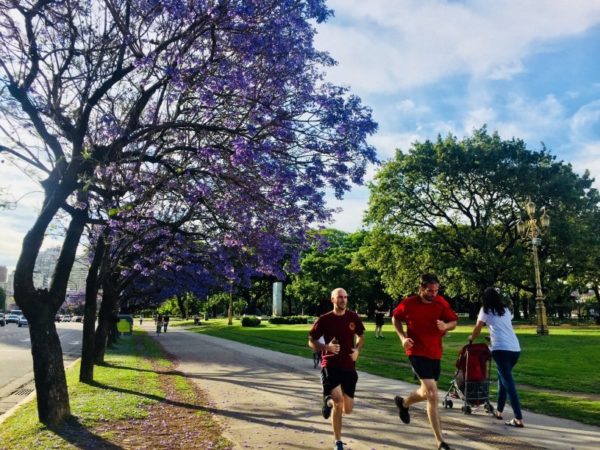
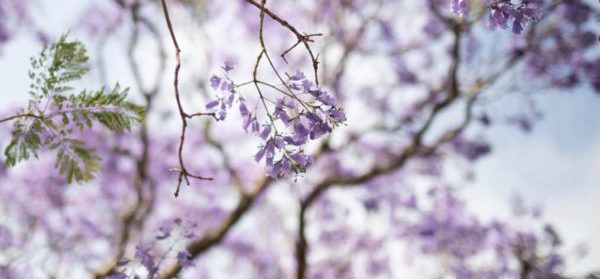

3
EUCALYPTUS TREE
Everyone born-and-raised San Diego knows the sight of the eucalyptus tree very well. These trees are everywhere! Even outnumbering palms, the eucalyptus are the most common tree along our city’s roads, parks, and canyons. They’re fast growing and ridiculously resilient in dry conditions, boasting of heights of over 100-feet tall in terrain where most vegetation consist of low-growing shrubs. There are over 700 species of eucalyptus tree, but only a handful are common sights in our city. These include the Tasmanian blue gum, red ironbark, silver dollar eucalyptus, and lemon-scented gum.
Origins
Of the 700 species of eucalyptus, most stem from Australia, but other species like the rainbow eucalyptus originate from the tropical rainforest of New Guinea and Asia. Eucalyptus trees made their way oversees to California in the 1800’s during the Gold Rush. It was a time when demand for wood was exceedingly high for construction and fuel purposes. As a result, deforestation became a huge concern, and in came the California Tree Culture Act of 1868 to save the day. Many trees were planted in large numbers during that period, but the eucalyptus became a standout tree due its remarkable growth rate and low maintenance.
Thousands of eucalyptus trees were planted, especially along roads. People were impressed by how quickly the eucalyptus sprouted, and they were happy that California was getting populated with trees—but then the tree’s hazardous nature began to unfold. You can read our previous article on “The Eucalyptus – Friend or Foe” to find learn more about why this once admired tree is considered by some to be “public enemy #1” when it comes to trees.
Maintenance
The eucalyptus tree is one of the most low-maintenance trees on the planet! This is why you see so many of them on city property and why you see droves of them in our canyons where zero supplemental water is given to them aside from the meager 12 inches of annual San Diego rain. The Tasmanian blue gum, which is the most common species in San Diego, has been considered to be the “world’s tallest weed.” This speaks volumes about its nature, as we have all seen weeds growing out of sidewalk cracks with only half a centimeter of seemingly unnutritious-looking dirt.
Even though the eucalyptus is a family of hundreds of differing species—some with pointed leaves and some with round; some with gray trunks and some with rainbow trunks—there is a common trait that they all share—bark shedding. This not only leaves messy debris on the ground below, but it can also cause brush fire concerns, as these dry bits of dead bark are highly flammable.
Due to the hazardous nature of the eucalyptus, these trees should be paid extra attention to. While they may be quick-growing, it is this same admired quality that contributes to their fragile structure. Throughout the year, we hear in the news about eucalyptus trees toppling over or branches suddenly falling and destroying a structure—or in the worst cases, killing a nearby bystander. Unlike many other trees, a failing eucalyptus branch does not usually show signs of failure. Instead it just suddenly drops—an incident so common that it is even coined the “sudden branch drop.”
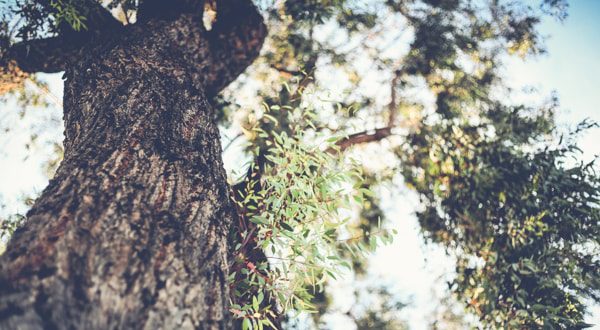
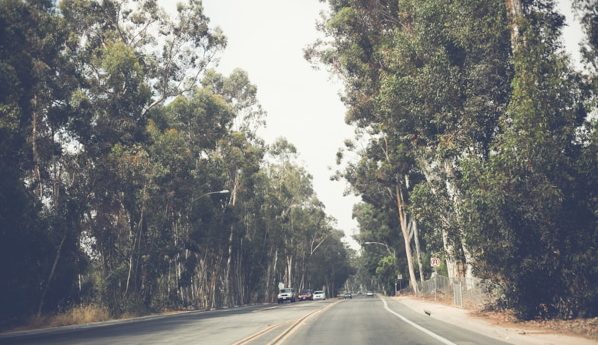
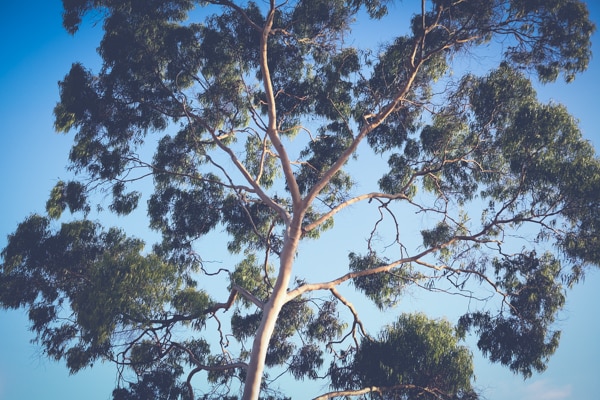
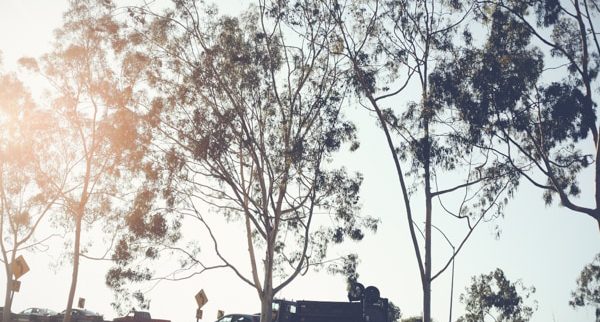
4
CARROTWOOD TREE
Sometimes the names of trees are brilliant, because they give you important bits of info into their history or their features. The Mexican fan palm came from—drumroll please—Mexico and has fronds that fan out. The blue gum eucalyptus has a blueish tint. The lemon-scented gum has a yellowish tint. The carrotwood tree … looks like a carrot? Not exactly. But if you peel away the outer layer of gray bark, you’ll reveal the orange inner layer of wood that gave this popular tree its unique name—carrotwood.
Ideal as a shade tree, the carrotwood is an evergreen, which means that it maintains its glossy, green foliage all year round. It has a moderate growth rate and reaches a maximum height of around 40 feet with a dense, oval-shaped canopy that can spread up to 30 feet in diameter. With its neat, easy-to-maintain canopy and hardy nature, the carrotwood has become a popular choice for San Diego property owners. And with the variety of land conditions in our city—from the salty coastal land of Solana Beach to the compact sidewalks Downtown and the East County heat—this highly-adaptable tree does well in all that our city can throw at it.
Origins
Originating from Australia, New Guinea, and Indonesia, the carrotwood tree is not a common sight in most of the United States—in fact, it only resides in Florida, California, and Hawaii. The earliest records that exist of the tree’s existence in the U.S. dates to 1955 in St. Lucie County, FL. Since then, the tree has grown rampant in Florida, even managing to make the state’s list of invasive species and being crowned as Florida’s “Most Invasive Plant Species Since 1955.” It has even made the state’s list of the most noxious weeds. Very interesting—because here in California, people seem to love their carrotwood trees…for the most part.
Maintenance
While the people of Florida may hate the carrotwood tree, the city of San Diego seems to love them and views them as a “well-behaved” tree. They’re a medium-sized tree, growing to about 40 feet in height at maturity. They are drought-tolerant, easy to maintain, and have little leaf-drop issues. So what’s not to love? Yes, the carrotwood may look clean and pretty, but don’t let the glossy, bright green leaves fool you—this tree has a dark side—hence making Florida’s “get-this-tree-out-of-here” black list.
One of the biggest complaints about the carrotwood is its annual fruit droppings. The tree produces copious amounts of little, orange fruit that encapsulates shiny, black seeds. Birds love them. People…not so much. These non-edible fruits drop by the thousands, making a vast mess to be cleaned.
But the fruity mess isn’t the biggest issue with the carrotwood—the roots are! Our tree trimmers and arborists see carrotwood root problems on a regular basis. These roots are strong, and they’re resilient. Not a good combination if you’re trying to remove a carrotwood from your property, or you’re trying to prevent structure damage. If you are planning on adding one of these trees to your property, it is wise to keep them at a safe distance of 10-15 feet away from any foundation or pavement. But you can plant them closer if root blocker is installed.
An annoying, yet amazing, trait about the carrotwood tree and its roots is its durability. These trees even have the grit to handle a large percentage of their roots being ground down, like in the case of urban development. When the carrotwood is situated too close to pavement or structures, its roots slowly lift whatever is in its way—be it dirt, sidewalk, or road. In these cases, a stump grinder comes in to remove the destructive roots. The root eradication method is enough to kill other tree species—but not the carrotwood. This tough cookie is here to stay!
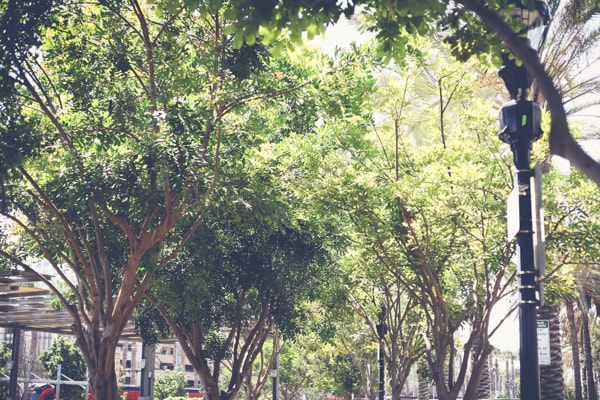
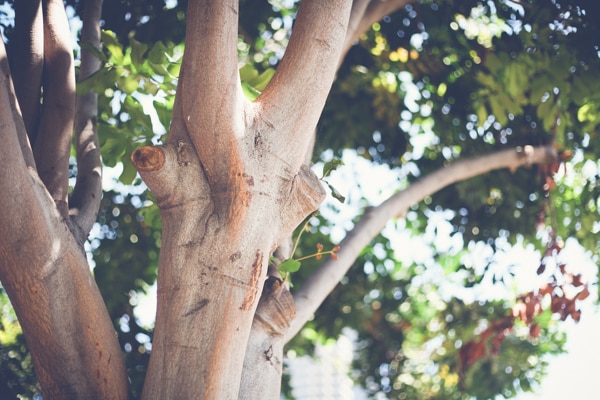
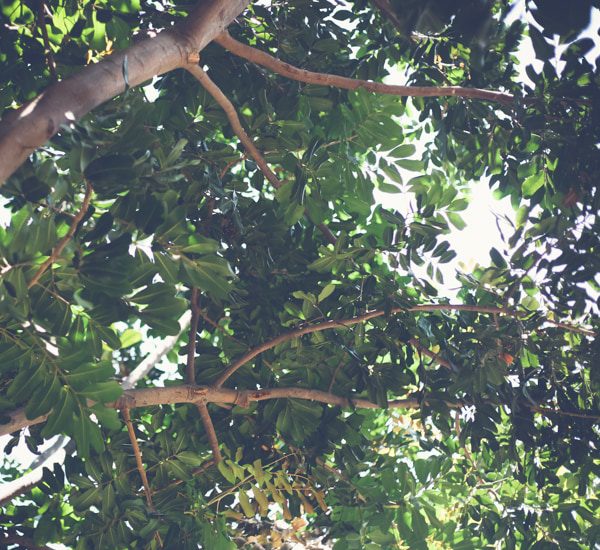
5
FICUS TREE
Our next tree our list of San Diego’s most popular trees is one that can be quite deceptive. You can find this tree indoors as an innocent little houseplant with its pointy, glossy leaves and pleasantly contained roots inside a 2-foot high vase. But what you may not know is that that little peanut of a tree has the potential to grow up to 100-feet tall with a dense canopy that spreads almost as wide as it is tall, and with a monstrous root system that moves and destroys anything in its path.
Say hello to the ficus tree!
The common ficus tree that is found throughout San Diego is also called the weeping fig or Ficus benjamina — but around town, it’s simply referred to as ficus tree. Did you know that this tree related to the fig tree and the majestic banyan trees that you see in Hawaii? Yes, the weeping fig is actually part of the Ficus genus that includes about 850 species of trees, shrubs, and vines. The ficus species is found both outdoors and indoors. It’s a very popular houseplant due to its attractive green color and easy maintenance. The weeping fig can tolerant unbelievably poor living conditions—such as being left to die in a pot on the side of a Pacific Beach alley way, surviving, and pushing its roots through cracks in the vase in search of water and food. True story!
The weeping fig ficus can be found lining many streets and shading many yards throughout San Diego. You can distinguish them by their stocky grayish trunks and their dense canopies filled with glossy, green leaves that are oval in shape with a pointy tip.
Aside from this commonly-found ficus tree, another renown ficus tree species in San Diego is the Moreton Bay fig. A unique feature about this particular tree is its aerial roots that drop from the tree’s limbs and take root once it reaches the ground. With the extra roots growing here, there, and everywhere, this tree is king of sturdy trees. You can find two remarkable Moreton Bay fig tree in Balboa Park—and when you do spot them, you just feel a natural inclination to stare in awe.
Origins
The weeping fig originates from Australia and Asia, even being the official tree of Bangkok. It’s history is unclear, but it was likely introduced by Kate Sessions.
Maintenance
Once well-established, the ficus requires little to moderate water. It’s a tough tree with a “survivor” mentality, so it sends its roots deep and wide to stake out the surrounding area for nourishment. This means that anything around better move or be moved! As you may have guessed, the roots of the ficus are as invasive as can be, and are creating costly repair projects for the city and private property owners. As these roots push up sidewalks, streets, and structure foundations, it creates hazardous conditions. As a result, many ficus trees throughout the city have been removed and replaced.
But all is not lost for the ficus tree. With their widespread, thick canopy, these trees are wonderful for shade purposes. As an evergreen, they maintain their green foliage throughout the year, and are tidy trees with little mess to clean. As long as reasonable measures are taken when planting these trees, damage issues can be minimized or eliminated. But take note—the ficus roots spread far! The root systems of trees typically grows past the height of a tree. With that in mind—the ficus tree typically grows up to 45-60 feet in height. Some say that 30 feet is a safe distance to plant a ficus, but it is still recommended that root blocker be used to avoid any unnecessary repairs.
The ficus tree has the capability of growing tall and wide, but its magnitude can be controlled with annual trimmings. Unlike most trees, the ficus can handle a severe trim, such as pollarding, where the trim is so drastic that little foliage is left behind. The foliage quickly grows back, but this tree trimming method is used to regulate growth in large trees, such as the ficus.
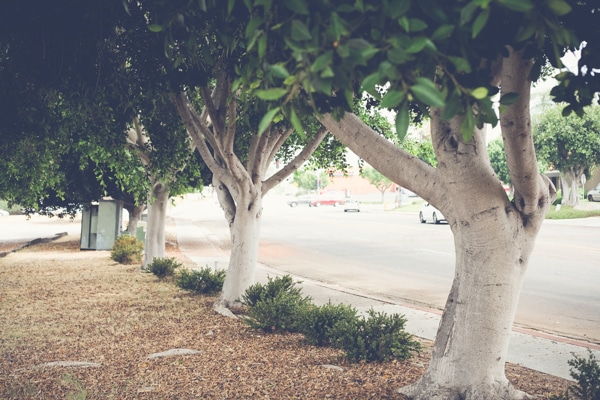
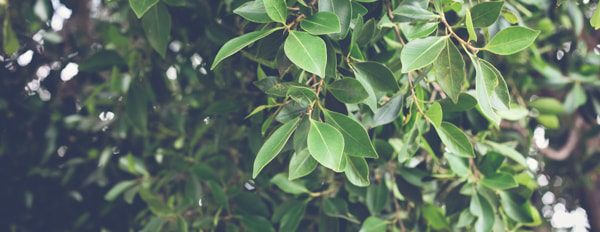
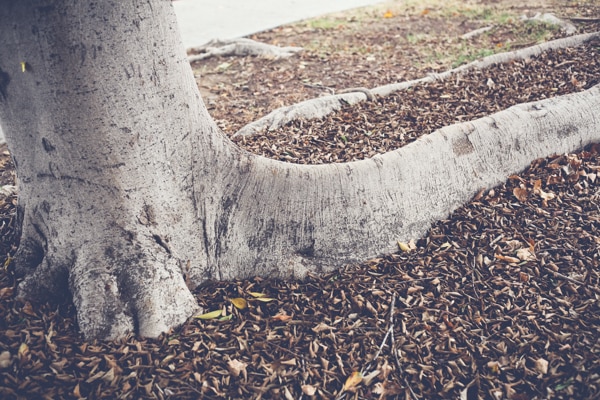
6
PINE TREES
Arguably the most common tree in the Northern Hemisphere is the pine tree. There are roughly 115 species of pines worldwide, forming vast stretches of evergreen forest, decorating cities with their evergreen pine needles, and amusing children around the globe with their fascinating pine cones. While most of the trees on this list originated from other countries, 17 pine species are actually indigenous to California–and one species, the Torrey Pine, is so rare, that up until recent years, it only grew in San Diego and Santa Rosa Island. However, Australia, New Zealand, and Kenya recently started growing this endangered species for timber use.
A variety of pines can be found around San Diego. If you spot a massive, round-shaped pine, then you are likely looking at a Torrey pine. See a tall, cone-shaped pine along the road? Then, that’s most likely a Canary Island pine. Other popular pine trees in our city include the Italian stone pine and Aleppo pine.
Pine trees are great because of their hardy nature. The common pines that we have in San Diego originate from similar Mediterranean climate regions, so they do well even when they are only provided a minimal amount of water.
Origins
Before the influx of trees that came in the late 19th and early 20th century, San Diego’s natural terrain composed mostly of dirt and sagebrush—but at least we had our Torrey pine! Then in an attempt to beautify our land, trees from throughout the world were brought in, such as many of the common pine trees that we see throughout our city. Most of these pines originate from similar climate zones without much rainfall and without extreme hot or cold temperatures, like the Mediterranean region.
Maintenance
As an evergreen, pine trees are green throughout the year—also meaning that they have a continual cycle of new pine needle growth and old pine needle die-off. Depending on where the pine tree is situated, this may or may not be an issue. Some property owners find this trait of the pine to be a huge nuisance, especially when pine needle cleanup seems to be a daily task with your patio furniture. But, if the pine is strategically placed afar from pavement and outdoor furnishing, then the needle mess wouldn’t be such a vexatious task—it would actually be welcomed, since the needles create a natural ground cover that effectively helps prevent weed growth.
Most pine species require a trimming every 2-4 years to keep the tree’s canopy from getting too thick and to remove any potentially hazardous limbs. How often you have your pine trimmed is not as important as WHEN you have it trimmed. The ideal time to have a pine tree trimmed is when temperatures are consistently 70 degrees or below, since this is when the trees go dormant and sap flow slows down. In San Diego, that short window would be in the winter, but depending on how the weather is playing out, you may be able to accomplish a successful trimming in the late fall and early spring. You should NEVER have your pine tree trimmed in the summer! This is when sap flow is at its peak, and trimming it in the summer could cause your tree to, in a sense, bleed to death. It will also cause an obnoxious sap cleanup that can damage car paint, outdoor furniture, sidewalks—basically anything underneath.
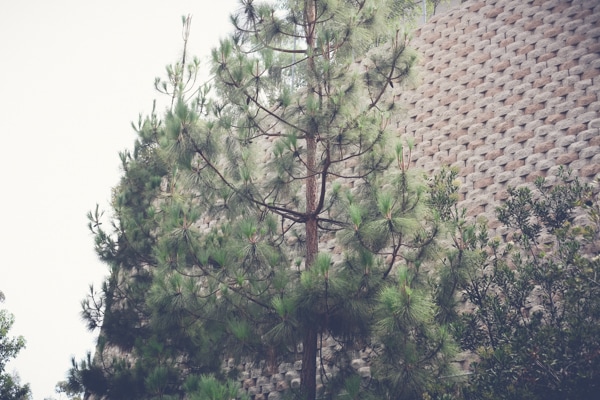
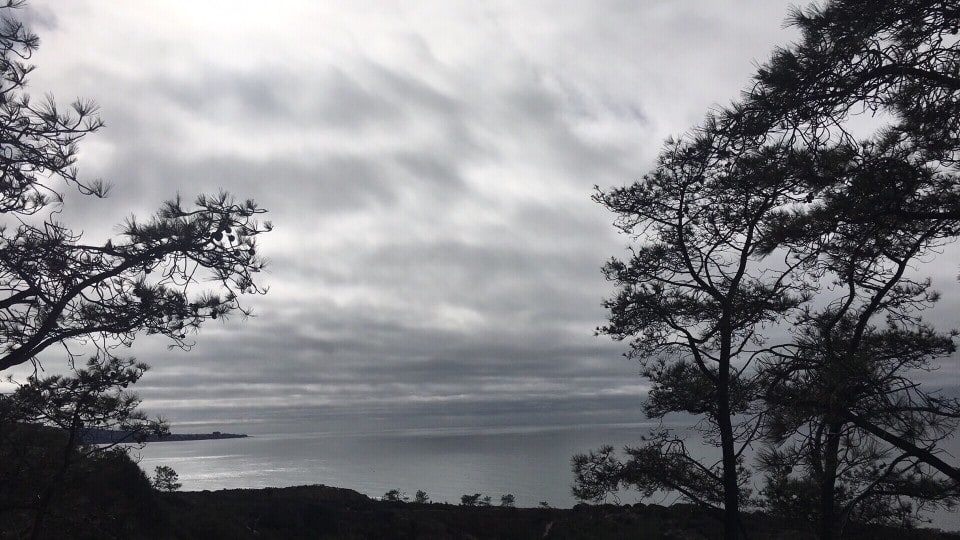
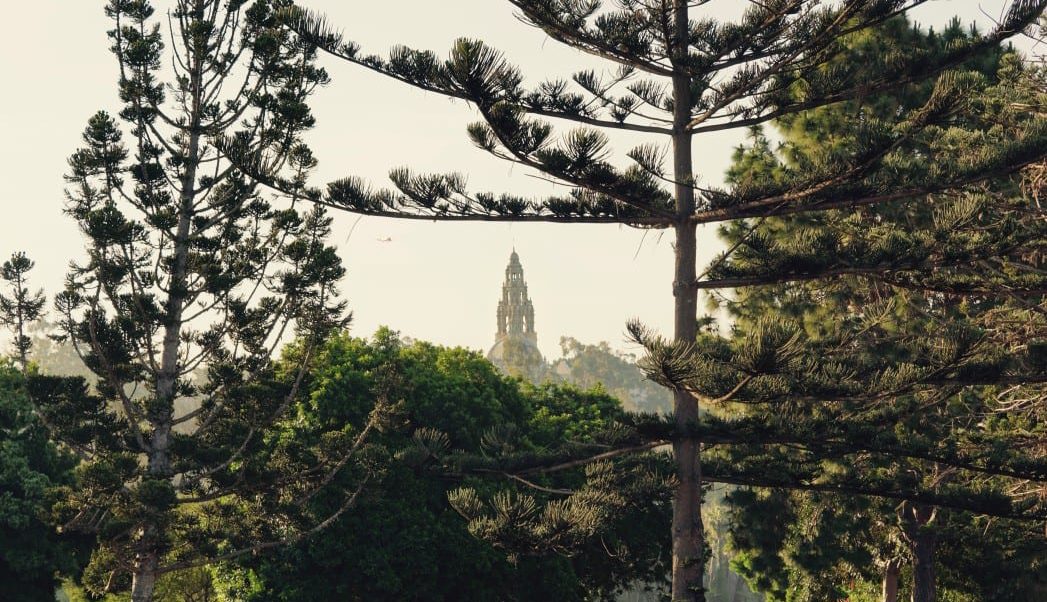
7
TIPUANA TREE
Have you ever noticed the trees with the yellow blooms on the side of the road that were 10-feet tall one year, then 20-feet tall two years later? That is our fast-sprouting Tipuana tipu tree, or Tipuana for short — or tipu, if you really want to get lazy. Tipuana…tipu…tomAYto…tomAHto. This tree has a become a favorite in recent decades for shade and ornamental purposes. They grow quickly and spread wide with their fern leaves and sunshine-colored flowers that bloom in the spring and summer seasons.
Developers love planting these trees along roads and as landscaping additions around properties for a variety of reasons: 1) they grow fast, 2) their roots are not destructive, and 3) they’re just plain beautiful when they bloom. The Tipuana is a soft-wood tree, which means that its limbs can be fragile—but it also means that its roots are not the strongest and are less likely to cause pavement and structure damage.
Similar to the jacaranda in looks (in fact, it’s also referred to as the yellow jacaranda), the tipu also has fern leaves and blooms during the same time of the year. Often these two flowering trees are planted together in communities to create a dazzling display during blooming season.
Origins
The Tipuana stems from Bolivia in South America. Not much is known about the history of the Tipuana’s emergence into San Diego, but it’s present popularity is likely a result of the efforts of Kate Sessions. Pacific Beach even has an iconic Tipuana tree named after the famed botanist. This historic tree was planted by Sessions at the site of her nursery at the corner of Garnet and Pico. It is estimated to be close to 100-years in age and is one of the largest tipu trees in Southern California.
Maintenance
As a tree service company, we see the good and bad in all trees. No tree is perfect! Not even our sunshine-speckled, perfectly sized, most-fun-name-to-say tipu tree. There is no doubt that the Tipuana is a beautiful tree that functions perfectly as a shade tree with its fast-growing, widespread canopy. It has the potential to grow to about 50 feet tall, with a spread that is just as wide. This tree is built for the heat, as it can tolerate even desert conditions, making it the “superhero” of the desert—because who wants to stare at brown dirt and cacti all day long? With their heat- and drought-tolerance, the Tipuana is a low-maintenance tree when it comes to water needs.
But now for the ugly. With all the dazzling, yellow blooms comes the messy aftermath of dead flowers to clean up, as well as the tree’s annual rainfall of small whip-like branches, just like its jacaranda friend. Some would argue that the colorful display makes the cleanup worth it, but others would rather not deal with it. Since the tipu is a fast-growing tree, it is wise to have it trimmed while it’s still young to encourage the desired shape. Otherwise, they can grow to look straggly and unkept. Trimming the tree back can also help eliminate branch failure since the tips tend to be weak and prone to breakage during storms.
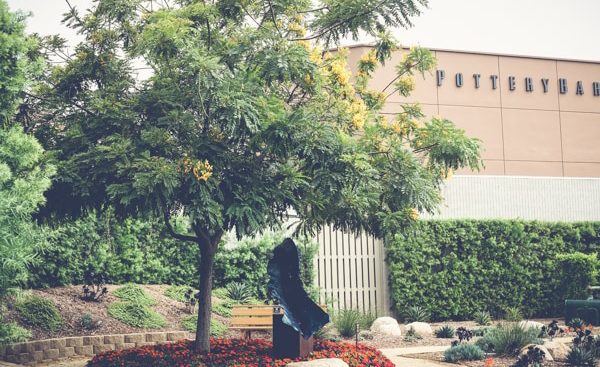
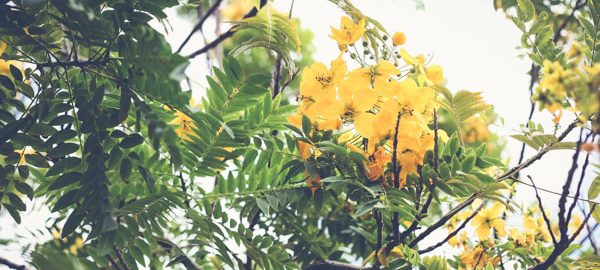
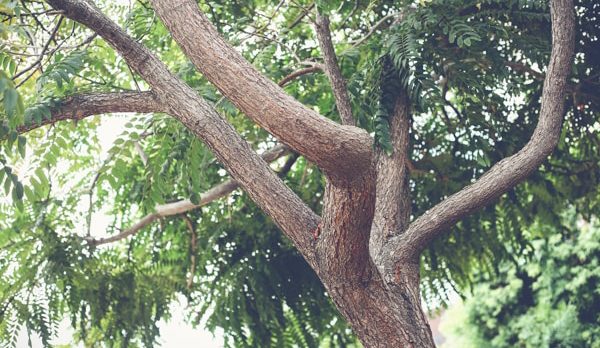
8
LIQUID AMBER TREE
Next up is the ONLY deciduous tree on the list of the 10 Most Popular Trees in San Diego—the liquid amber tree, also called the American sweetgum or liquidambar. Being in a park surrounded by these trees during the fall season makes you feel like you’re in the East Coast. They bring about an autumn experience that we don’t get much of in San Diego with their yellow, orange, and red-colored leaves and actual autumn leaf-drop that makes you all of a sudden feel like drinking a warm cup of hot apple cider.
The liquid amber can be distinguished by their five-point, maple-like leaves that are a bright green throughout the year and a brilliant amber color in the fall. These trees tend to grow tall (up to 70-feet) and sometimes cone-shape in appearance. Other times they look more like a long, green blob on a stick…but a pretty glob, at least.
Even though the tree’s leaves turn a beautiful amber color in the fall, the tree actually derived its name from its amber-colored sap. Amber on the outside, amber on the inside, amber, amber, amber!
Origins
The liquid amber originates from Mexico, Eastern America, and Central America. The first known record of the tree is by a Spanish naturalist in 1615 who described the liquid amber as a large tree that produced a fragrant amber liquid—hence giving it the genus name Liquidambar, which literally means liquid amber.
During the late 1900’s, the liquid amber became a popular landscaping tree in California. In a region where autumn yellows and reds are sparse, the liquid amber was sought after for its reliable seasonal colors. It brought a touch of the East Coast to the West Coast, allowing San Diego residents to actually share in the experience of raking leaves.
Maintenance
Its colors may give you that warm, fuzzy feeling—but watch your step—it’s seed pods may give you that spiky, painful feeling! Perhaps, the biggest nuisance of the liquid amber tree is its hard, spiky seed pod that the tree releases during the fall and winter. These pods are durable and mean, as their tough cover has a single purpose—to protect the seeds inside it. Slow to decompose, if left on the ground, they end up littering the area and creating a safety hazard.
Being the deciduous tree that it is, the liquid amber tree drops its leaves in the winter, requiring a good old-fashioned raking. Needless to say, this would not be the tree for you if you’re not the type of person to want to rake leaves or be responsible for littering the neighborhood street in a land of evergreen trees and palms.
Roots can also be an issue if the liquid amber is planted too close to structures and pavement. While the city of San Diego loves to plant these trees in urban areas and along roadsides, we, as arborists, do not recommend it—not only to avoid a spiky seed pod mess, but mostly to avoid its destructive root issues. Ideal planting locations would be an open area where encountering their spiky balls wouldn’t be an issue, and their roots are given adequate spacing to spread.
The liquid amber prefers moist soil, but still does well in dry conditions—which is why they were brought to California. They prefer partial to full sun and once established, they require little water maintenance.
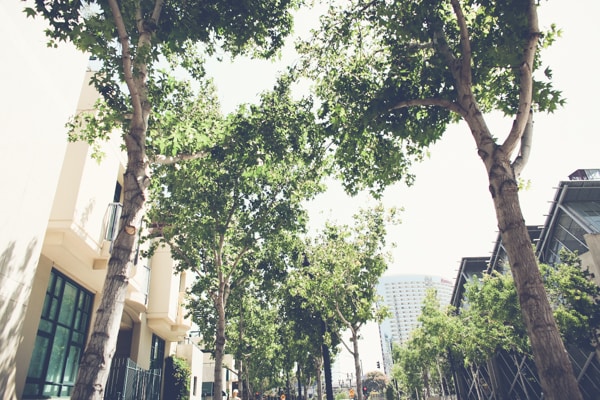
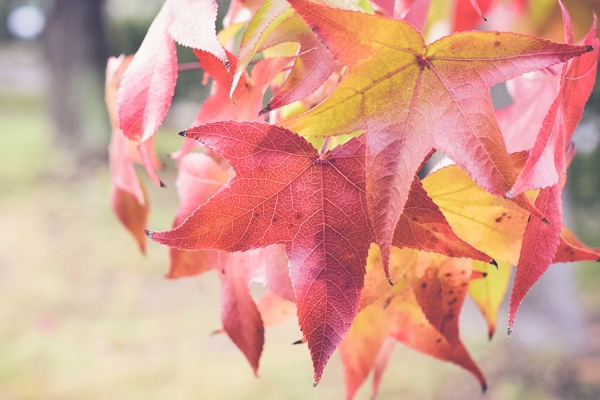

9
PEPPER TREE
While the Torrey pine may be the only indigenous tree on this list, there is another tree that goes way back to San Diego’s beginnings—the California pepper tree. This historic tree decorates the city of San Diego with its whimsical, drooping, feathery foliage. It almost makes you feel like you’re in the South amongst the weeping willows. But unlike the weeping willow, the pepper tree is an evergreen so it stays green year-round and it requires a quarter the amount of water. I guess you can say that it’s dry Southern California’s version of the South’s weeping willow.
Where did the pepper tree get its name? It’s not the source of the black peppercorns that we use in the kitchen, but it does produce a different type of pepper berry that can be found in dense clusters year-round in the tree. These berries start off green, then changes to red, pink, or purplish in color. Opinions about the consumption of the peppers is mixed. Some say that its a great culinary addition in small quantities—others say that it is toxic and can lead to digestion issues.
Origins
Some may call it the California pepper tree. Others call it the Peruvian pepper tree. And some just combine the two and call it the California Peruvian pepper tree. Which one is it? Well, the fact of the matter is—we, Californians, stole the name! Shame shame! The pepper tree originates from the South American country of Peru, where the natives have been using the wood and berries for thousands of years for medicinal and spice purposes.
Then the pepper tree entered California’s history around 1825 when a sailor from Peru stayed as a guest at the Mission San Luis Rey in Oceanside. As a gift, he gave Father Antonio Peyri a handful of pepper seeds, which were planted around the mission and sprouted into fragrant, graceful pepper trees. The oldest pepper tree in California still exist today and can be seen at the same mission where this tree species began its California journey.
Maintenance
Just as consumption of the pepper tree’s berries has mixed opinions, so does the pepper tree in its entirety. Some people love them. Some people hate them.
They are a great source of shade and greenery to any landscaping, but the main issues with the pepper tree usually deals with their invasive nature and their roots (surprise surprise). In some states, this tree is on the invasive plant species list, meaning they crowd out the native plants and negatively change the eco-system around them. Plants on these lists are called invasive for a reason — invasions are hard to stop, just as their propagation can sometimes feel like an impossible task. Like many invasive trees, the pepper tree’s roots are aggressive and will destroy development around them in search for water and nutrients. So if you plan on planting a pepper tree on your property, make sure to give it plenty of room to spread and/or use root blocker.
Pepper trees require maintenance by a professional tree trimmer every 2-3 years. This tree has an ugly habit of sprouting limbs at the bottom of its trunk, and if the new sprouts are not trimmed off and the older limbs trimmed back, then the tree ends up looking like a giant bush.
Pepper trees are a fast-growing tree that requires little water once well-established—explains why they quickly become so popular in Southern California. They also do very well in the heat. They’re a common ornamental tree in San Diego’s East County — even having a street named after them in El Cajon.

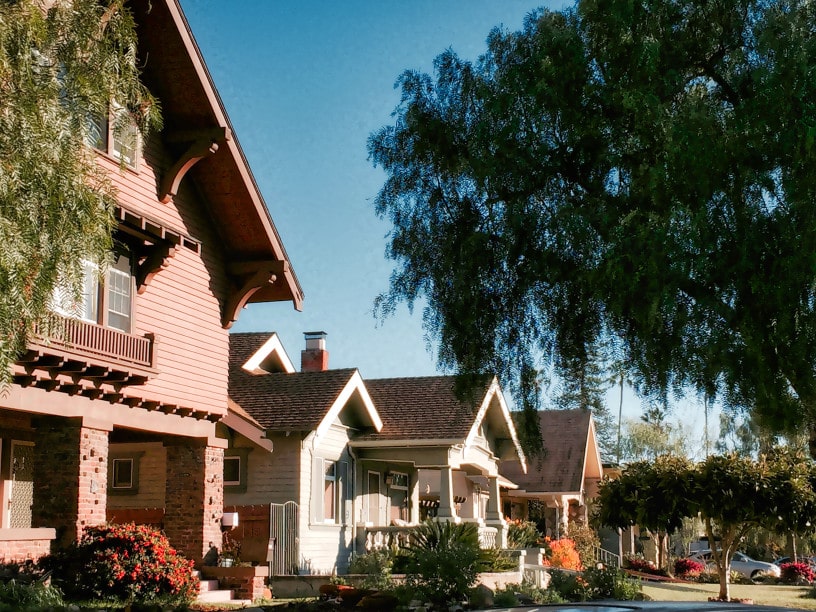
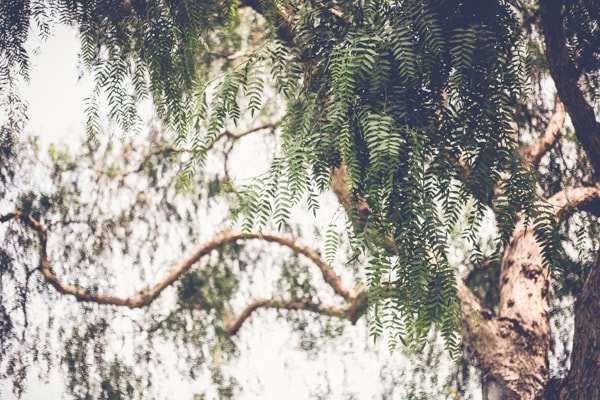
10
PODOCARPUS TREE
You may be wondering, isn’t there a tree on this list that doesn’t have so many issues? Well…yes and no. You won’t find a single tree that doesn’t drop leaves or seeds. That’s how they were created for survival. But you can avoid root issues with pavement-friendly trees like the podocarpus—one of our most well-behaved, popular trees in San Diego!
The podocarpus tree is also known as the fern pine, even though it’s not actually a pine, but it was given the name for its evergreen, narrow foliage. If you want to add a beautifully green, decorative tree to your landscape with little worry for root destruction, then the podocarpus is a great choice. It works wonderfully as an urban, shade tree, because it does well in confined areas. It is important to give the tree’s canopy room for growth, since it can grow up to a span of 20 feet and has the capacity to grow to about 60 feet in height—although it is typically a medium-sized tree that grows to about 20-40 feet tall.
Origins
Most of the trees on this list originate from other parts of the world. The podocarpus is no different—BUT it does have a bit more of a cool factor to its introduction to California, because this tree’s history involves nature-loving President Theodore Roosevelt. Native to East Africa, legend is that President Roosevelt brought back podocarpus seeds from a 1909 African safari. He later gave sprouted seeds to a Southern California horticulturalist who then shared them with Kate Sessions—and the rest is history.
Maintenance
The podocarpus tree is admired for its clean appearance, low maintenance, hardiness, friendliness to sidewalks, and resistance to pests and disease. Because of its dense canopy, this tree works great as a shade tree or privacy screen. It prefers partial to full sun and does well even in heat spells and drought conditions. Tree trimmers love the podocarpus tree, because its easy to prune and can take on fun shapes. While they are normally trimmed into a circular or oval shape, sometimes you can spot them shaped into a cylinder, spirals, or tiered balls.
The only complaint about the podocarpus tree is their seed fall. At maturity, the female trees will drop copious amounts of fleshy seeds that create a litter issue.
